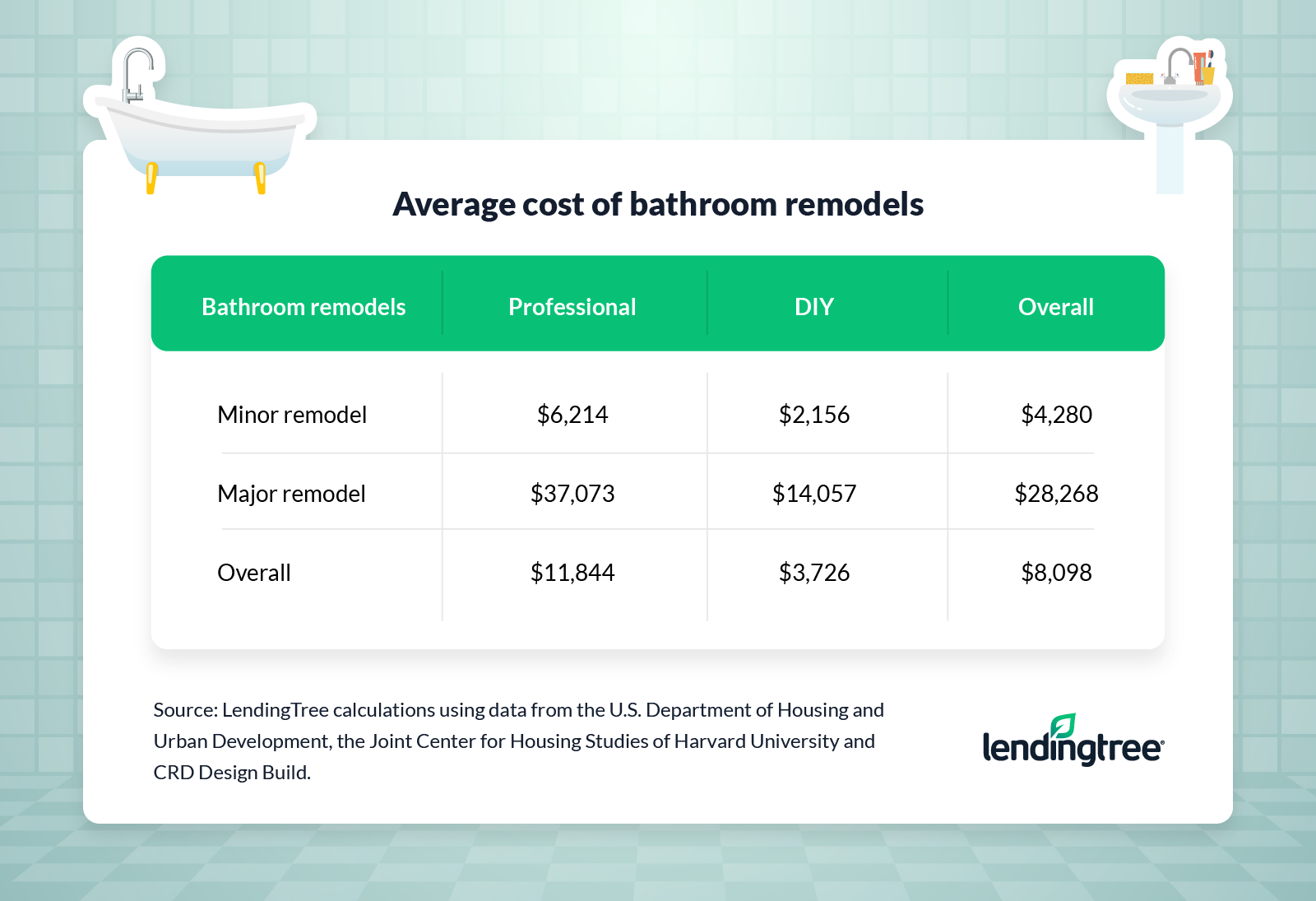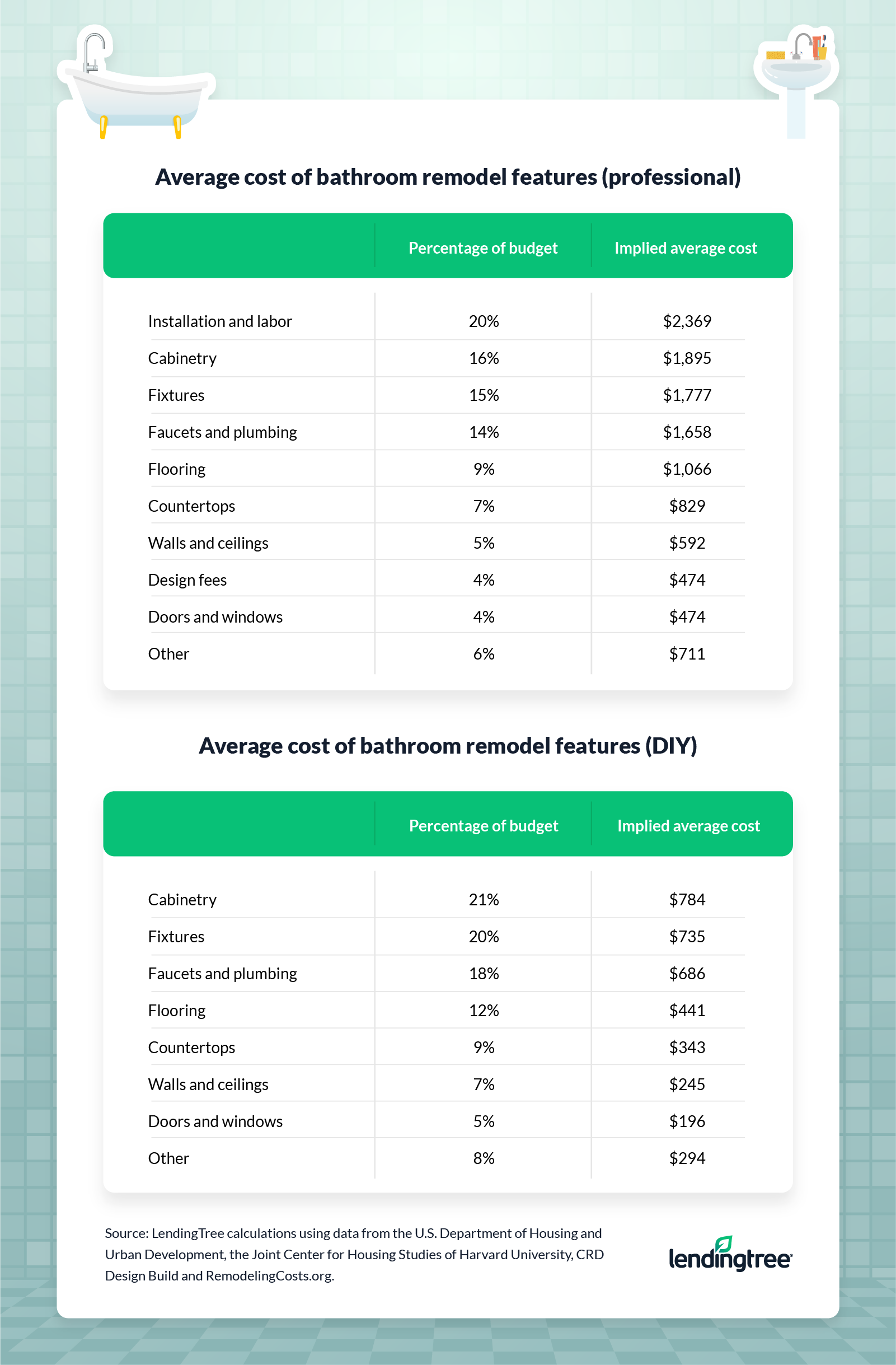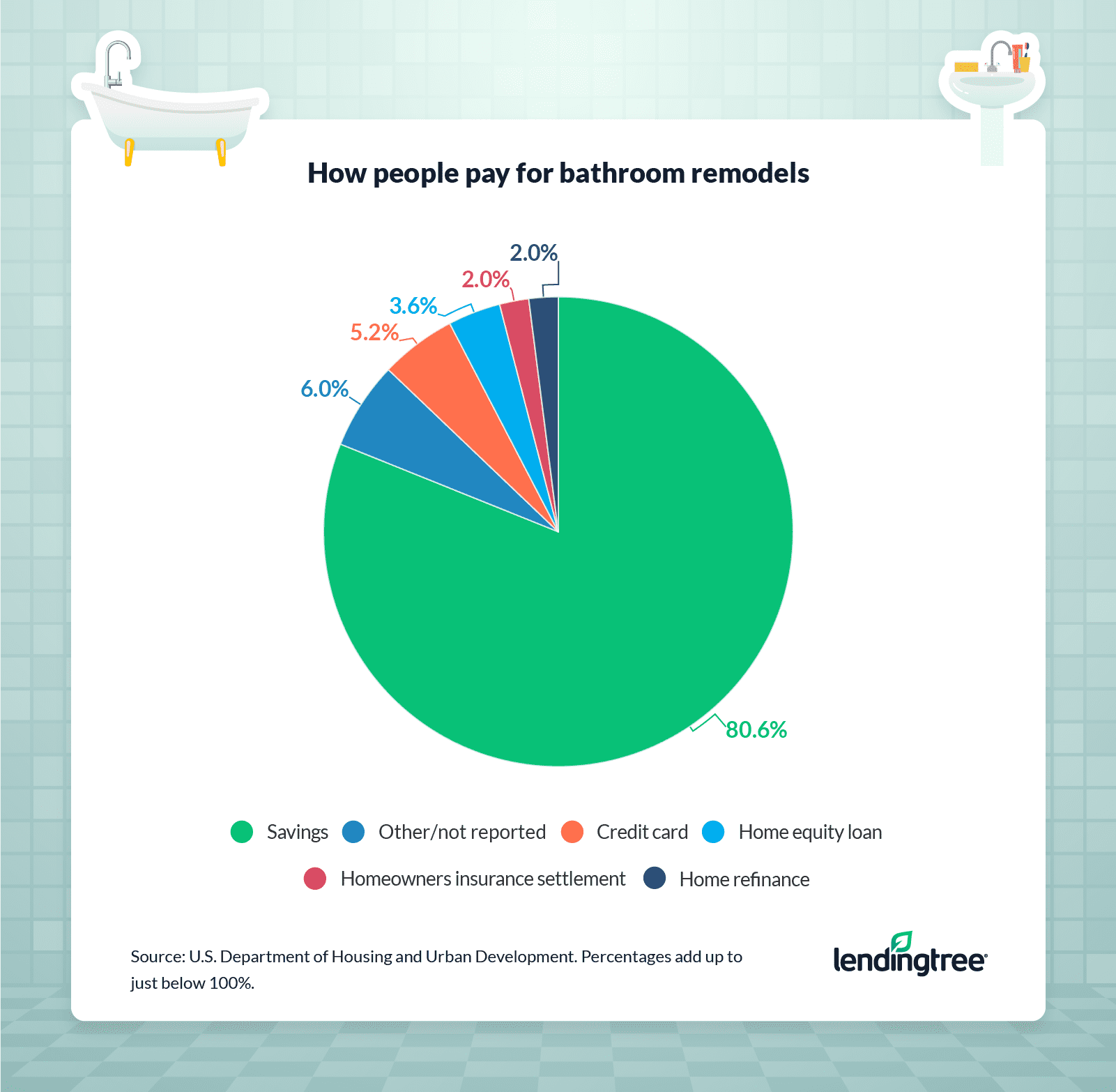The Average Bathroom Remodel Cost Is $8,098
The average bathroom remodel cost in the U.S. in 2021 is $8,098. This cost has risen significantly — an estimated 20% — since the start of 2020.
However, there can be a wide range in the cost of a bathroom remodel depending on whether it’s a minor project or a full overhaul — and whether you’re doing it yourself or hiring a professional.
TABLE OF CONTENTS
Average bathroom remodel cost
While the average bathroom remodel cost is $8,098, there’s a significant difference in what people spend on a minor bathroom remodel and a major bathroom remodel.
A minor bathroom remodel costs an average of $4,280. Minor updates can include the following, according to construction and remodel companies:
- Replacing faucets and fixtures
- Changing handles, knobs and other hardware
- Painting or refacing cabinets
- Replacing the mirror
- Changing light fixtures
- Adding new flooring
Major bathroom remodels are significantly more expensive, as these renovations cost an average of $28,268. In a major bathroom remodel, you might do the following:
- Replace the tub or shower
- Put in floor-to-ceiling tile
- Install a new vanity, cabinets and toilet
- Adjust plumbing and electrical systems
- Add or remove walls
These costs have increased significantly over the past few years as homeowners invest more time and money on renovations. Since the start of 2020, the average cost to remodel a bathroom rose by 20%, according to CRD Design Build.
Professional bathroom remodeling vs. DIY bathroom remodeling
Bathroom remodel costs will change depending on whether you do the work yourself or hire a contractor. A DIY bathroom remodel costs an average of $3,726, while a professional bathroom remodel costs an average of $11,844.
A similar spread is evident for both major and minor bathroom remodels. Here is how the costs break down:
| Costs: Professional vs. DIY (by remodeling type) | ||
| Professional | Do-it-yourself | |
| Minor bathroom remodel | $6,214 | $2,156 |
| Major bathroom remodel | $37,073 | $14,057 |
The differences in costs come from the price of labor and the profit margin that professional remodeling companies include in their pricing to stay in business. If you’re doing the project yourself, your costs are limited to the cost of materials and any tools you need.
As you’re considering whether to complete your bathroom remodel yourself or hire a pro, ask yourself the following questions:
- Do I have the skills necessary to complete the work?
- Do I have the necessary tools?
- Can I allot the required time?
- Can I handle the risk of mistakes and damage?
- Do I need to work on electrical or plumbing?
- Can I dispose of debris myself?
How much does a bathroom remodel cost by feature?
If you’re hiring a professional contractor to do the remodel, your main expense will be labor. If you’re doing a bathroom remodel yourself, the main costs are materials.
In a professional remodel, labor and installation accounts for 20% of the total cost on average, or $2,369. That’s the biggest budget item, as you’ll see in this chart detailing the costs:
| Average cost of bathroom remodel features (professional) | ||
| Feature | Percentage of budget | Implied average cost |
| Installation and labor | 20% | $2,369 |
| Cabinetry | 16% | $1,895 |
| Fixtures | 15% | $1,777 |
| Faucets and plumbing | 14% | $1,658 |
| Flooring | 9% | $1,066 |
| Countertops | 7% | $829 |
| Walls and ceilings | 5% | $592 |
| Design fees | 4% | $474 |
| Door and windows | 4% | $474 |
| Other | 6% | $711 |
In a DIY remodel, you’re covering the installation and labor yourself. Thus, your biggest expense will be for the cabinetry — 21% of your budget, at an average cost of $784. You’re also avoiding design fees and a few other costs, including removing and disposing of old materials.
| Average cost of bathroom remodel features (DIY) | ||
| Feature | Percentage of budget | Implied average cost |
| Cabinetry | 21% | $784 |
| Fixtures | 20% | $735 |
| Faucets and plumbing | 18% | $686 |
| Flooring | 12% | $441 |
| Countertops | 9% | $343 |
| Walls and ceilings | 7% | $245 |
| Door and windows | 5% | $196 |
| Other | 8% | $294 |
However, keep in mind that when you’re doing a bathroom remodel yourself, you’ll be responsible for covering the costs of any mistakes or damage — costs that a professional remodeler would have to eat if they were doing the project. Insurance may also cover damage done by a contractor, but it might not cover damage if you do the work yourself. You may also have to invest in the right tools to complete the project, which can add up quickly.
If you’re doing the project yourself, make sure you’re planning and budgeting for the costs of replacement materials if you make a mistake. If you’re hiring a pro, be sure you have wiggle room in your budget to cover contingencies like hidden rot, unexpected plumbing and electrical repairs, and other surprise costs that might result in a change order.
These bathroom features are growing in popularity
Certain bathroom features, such as doorless showers and spa-like designs, are growing in popularity for those looking to remodel, though these trends change over time.
According to the American Institute of Architects, here are the bathroom features that saw increased interest in the fourth quarter of 2020, compared with the fourth quarter of 2019:
- Doorless/no-threshold showers: 62%
- Large walk-in showers: 58%
- Adaptability/universal design: 57%
- Tubless shower: 56%
- High-end, spa-like design: 43%
- Increased natural lighting (windows and skylights): 38%
- Radiant heated floor: 34%
Other projects cited in smaller numbers include stand-alone tubs, smart toilets and towel warming racks.
How to finance your bathroom renovation
The vast majority of homeowners — 80.6% — pay for bathroom renovations with their savings, according to the U.S. Department of Housing and Urban Development. This is by far the cheapest way to finance a remodeling project. There’s no interest to pay, loans to apply for or approvals to seek.
But that’s not the only way to fund the bathroom remodel cost. There are several methods of borrowing money to pay for a bathroom remodel should you not have the cash on hand.
| How homeowners pay for bathroom renovations | |
| Financing method | % on remodeling |
| Savings | 80.6% |
| Other/not reported | 6.0% |
| Credit card | 5.2% |
| Home equity loan | 3.6% |
| Homeowners insurance settlement | 2.0% |
| Home refinance | 2.0% |
Nearly 170 million Americans carry at least one credit card, allowing consumers to make a large purchase and pay it off later. Since there’s a good chance you already have a credit card, it could be a convenient way to pay for a bathroom remodel. Plus, as an unsecured loan, there’s no risk of losing your home if you fail to make your payments.
However, if you’re not able to pay off your balance by the end of your billing period, you’ll owe interest. Because credit card interest rates can be steep, you could owe significantly more than if you financed the project another way. If you’re not able to get a 0% APR introductory offer or quickly pay off the bathroom renovations, you might want to consider another option.
Home equity loans
Home equity is the difference between what you owe on your mortgage and what your property is worth. There are two primary ways you can borrow against this value to fund a bathroom remodel:
- Home equity loan: This is a lump-sum loan you take out and pay back at a fixed interest rate over a period of years. You’re typically limited to borrowing a certain percentage of your home’s equity — often 85%.
- Home equity line of credit, or HELOC: This works much like a credit card. You have a certain amount you can spend, limited by the amount of equity in your home. During the initial draw period, you can spend as much or as little of the line of credit. After, you enter a repayment period, in which you pay back the amount you spent with interest.
Your property secures both home equity loans and HELOCs. This means you risk foreclosure if you fail to make your payments. However, these loans generally carry lower interest rates than unsecured loans like credit cards and personal loans.
Homeowners insurance settlements
If your bathroom was damaged by a disaster or accident, you may receive a homeowners insurance settlement check to pay for the remodel. The amount you receive will be dictated by the extent of the damage and your specific policy. The process can be confusing and time-consuming, however. You may end up needing to reopen your claim after initially settling if you find more damage. Some insurance companies will require that they pay a contractor directly to repair damage rather than send you the money directly.
Home refinancing
When you refinance your mortgage, you take out a new loan to pay off and replace the one you already have. When you do this, you may be able to take cash out. In a cash-out refinance, your new loan is for a larger amount than you owe, and the difference comes as cash. This can be a good way to pay for a remodel, especially if you can save money on your monthly payment through a lower interest rate. However, when you take out cash, you’re reducing the amount of equity in your home.
Personal loans
While not included in the U.S. Census Bureau data, personal loans can also be a good way to pay for a bathroom remodel. A June 2020 survey from LendingTree found that 26% of people who used a personal loan for home improvement used the loan for a bathroom remodel, making it the second-most common project.
Personal loans are typically unsecured and paid back at a fixed interest rate. You can use the proceeds of a personal loan for various purposes, and interest rates are generally lower than that of a credit card. But since these loans are often unsecured, you’ll pay higher rates than on a home equity loan.
| Ways to finance a bathroom remodel: Pros and cons | ||
| Pros | Cons | |
| Savings |
|
|
| Credit cards |
|
|
| Home equity loans |
|
|
| Homeowners insurance settlement |
|
|
| Refinance |
|
|
| Personal loans |
|
|
As you evaluate whether to move forward with a bathroom remodeling project, look at the methods you have available to pay. Weigh the costs you’ll face in financing the project versus the value you’ll get from it.
How to save money during a bathroom remodel
If the average bathroom remodel cost feels steep, there are some ways you can save money during the project. A budget bathroom remodel is very doable.
- Repaint instead of replace. You could achieve the look you’re going for by putting a new coat of paint on cabinets or vanities instead of replacing them, saving you money.
- Do part of the work yourself. You don’t have to choose to fully DIY the project or use a contractor for everything. You may be able to farm out just the plumbing and electrical, or do the demo yourself and then have a pro piece the bathroom back together.
- Keep plumbing and electrical in place. Moving these systems can be expensive. As you put together your new bathroom design, you could be sure to keep them in place.
- Skip tile. Buying and installing tile can be costly. Consider other, cheaper materials like laminate flooring or prefabricated shower surrounds.
- Find used materials. You might be able to get a unique design by combing through Craigslist or eBay for reclaimed materials, or ask a home improvement store if they have any returns they can sell you for a discount.
Bathroom remodeling FAQs
How much are Americans projected to spend on bathroom remodels in 2021?
U.S. homeowners are projected to spend nearly $32 billion on bathroom remodels in 2021, according to the National Kitchen and Bath Association. Overall, Americans spent nearly $420 billion on home improvement projects in 2020, according to the Joint Center for Housing Studies of Harvard University, and that figure is expected to rise to more than $430 billion this year.
How do I stick to my budget?
Be clear about your budget when selecting a contractor. Many bathroom remodelers have experience with various price ranges and can help walk you through the choices you can make to stay within your budget.
How much can homeowners expect to recoup in a home sale?
A midrange bathroom remodel can bring back an average of 60% of the amount you spend in a home sale, according to the Cost vs. Value 2021 tool from Remodeling magazine. Its data considers a midrange project to cost about $24,000. An upscale bathroom remodel, costing about $75,000, will have a return on investment of just less than 55%, according to the magazine.
Can people remain in their house during a bathroom remodel?
Yes, you can usually remain in your home during a bathroom remodel — provided that your home has more than one bathroom. However, any renovation can be disruptive, so keep this in mind, especially if you work from home.
Should I remodel my bathroom in phases?
Remodeling in phases can be a good way to get the bathroom of your dreams, especially if you’re paying in cash. You can do a little at a time and pay for it as you go. However, this option will prolong the disruption to your daily life.
Is a bathroom remodel worth it?
It depends. If you’re planning on moving soon, it might not be since you will only recoup a fraction of the money you put in when you sell the home. But if you’re planning on sticking around for a while, the enjoyment you get from an updated bathroom can be well worth the cost.
Sources
- U.S. Department of Housing and Urban Development
- Joint Center for Housing Studies at Harvard University
- CRD Design Build
- National Association of Home Builders
- RemodelingCosts.org
- American Institute of Architects
- LendingTree internal data
- National Kitchen and Bath Association
- Remodeling magazine
Additional graphics for reporters
Reporters looking to include this data on their website can use the following graphics:



